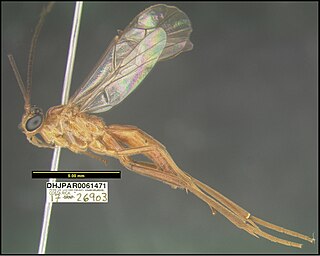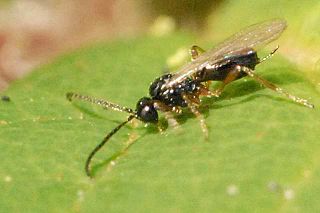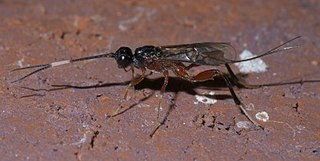
The Stephanidae, sometimes called crown wasps, are a family of parasitoid wasps. They are the only living members of the superfamily Stephanoidea. Stephanidae has at least 345 living species in 11 genera. The family is considered cosmopolitan in distribution, with the highest species concentrations in subtropical and moderate climate zones. Stephanidae also contain four extinct genera described from both compression fossils and inclusions in amber.

Microgastrinae is a subfamily of braconid wasps, encompassing almost 3,000 described species, with an estimated 30,000–50,000 total species. This makes it one of the richest subfamilies with the most species of parasitoid wasps.

The Cheloninae are a cosmopolitan subfamily of braconid parasitoid wasps.

Agathidinae is a subfamily of braconid parasitoid wasps. Some species have been used in biological control programs.

The Doryctinae or doryctine wasps are a large subfamily of parasitoid wasps within the family Braconidae.

Meteorus is a genus of parasitoid wasps in the family Braconidae. It comprises over 330 species worldwide.

Dinotrema is a genus of wasps in the family Braconidae. Species are amongst the largest parasitoid wasps in the tribe Alysiini (Alysiinae). There are approximately 350 species described around worldwide.

The Alysiinae are a subfamily of braconid parasitoid wasps with over 1000 described species. Several species have been used in biocontrol programs. They are closely related to the Opiinae.

The Rogadinae are a large subfamily of braconid parasitoid wasps. Several Rogadinae species parasitize pest caterpillars and are important for naturally occurring biological control.

The Homolobinae are a subfamily of braconid parasitoid wasps.
Syntretus is a genus of parasitoid wasps. Most parasitize adult hymenopterans, though one species parasitizes adult Drosophila fruit flies.

Blacini is a tribe of braconid Parasitoid wasps.

Brachistinae is a subfamily of braconid wasps in the family Braconidae.

Trachionus is a genus of braconid wasps in the family Braconidae. Larvae are parasitoids of larvae from the genus Phytobia.

Helconinae is a subfamily of braconid wasps in the family Braconidae.
Sathon is a genus of braconid wasps in the family Braconidae. There are more than 20 described species in Sathon, found throughout the world.

Biosteres is a genus of wasps belonging to the family Braconidae.
Diospilini is a tribe of parasitoid wasp belonging to the family Braconidae and subfamily Brachistinae.
Clinocentrini is a tribe of parasitoid wasp in the family Braconidae. It is represented in the whole world. It is sister to Betylobraconini + Gondwanocentrini.
Rogadini is a tribe of parasitoid wasp in the family Braconidae. It is represented in the entire world. It is the largest tribe within the subfamily Rogadinae with 40 extant genera. It is also considered to be the most basal tribe in the subfamily.
















